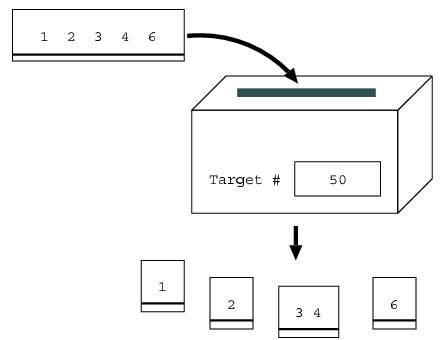poj 1416 Shredding Company
来源:互联网 发布:一淘网跟淘宝网 编辑:程序博客网 时间:2024/05/21 04:43
题目链接:点击打开链接
Description
You have just been put in charge of developing a new shredder for the Shredding Company Although a "normal" shredder would just shred sheets of paper into little pieces so that the contents would become unreadable, this new shredder needs to have the following unusual basic characteristics.
1.The shredder takes as input a target number and a sheet of paper with a number written on it.
2.It shreds (or cuts) the sheet into pieces each of which has one or more digits on it.
3.The sum of the numbers written on each piece is the closest possible number to the target number, without going over it.
For example, suppose that the target number is 50, and the sheet of paper has the number 12346. The shredder would cut the sheet into four pieces, where one piece has 1, another has 2, the third has 34, and the fourth has 6. This is because their sum 43 (= 1 + 2 + 34 + 6) is closest to the target number 50 of all possible combinations without going over 50. For example, a combination where the pieces are 1, 23, 4, and 6 is not valid, because the sum of this combination 34 (= 1 + 23 + 4 + 6) is less than the above combination's 43. The combination of 12, 34, and 6 is not valid either, because the sum 52 (= 12 + 34 + 6) is greater than the target number of 50.

Figure 1. Shredding a sheet of paper having the number 12346 when the target number is 50
There are also three special rules :
1.If the target number is the same as the number on the sheet of paper, then the paper is not cut.
For example, if the target number is 100 and the number on the sheet of paper is also 100, then
the paper is not cut.
2.If it is not possible to make any combination whose sum is less than or equal to the target number, then error is printed on a display. For example, if the target number is 1 and the number on the sheet of paper is 123, it is not possible to make any valid combination, as the combination with the smallest possible sum is 1, 2, 3. The sum for this combination is 6, which is greater than the target number, and thus error is printed.
3.If there is more than one possible combination where the sum is closest to the target number without going over it, then rejected is printed on a display. For example, if the target number is 15, and the number on the sheet of paper is 111, then there are two possible combinations with the highest possible sum of 12: (a) 1 and 11 and (b) 11 and 1; thus rejected is printed. In order to develop such a shredder, you have decided to first make a simple program that would simulate the above characteristics and rules. Given two numbers, where the first is the target number and the second is the number on the sheet of paper to be shredded, you need to figure out how the shredder should "cut up" the second number.
1.The shredder takes as input a target number and a sheet of paper with a number written on it.
2.It shreds (or cuts) the sheet into pieces each of which has one or more digits on it.
3.The sum of the numbers written on each piece is the closest possible number to the target number, without going over it.
For example, suppose that the target number is 50, and the sheet of paper has the number 12346. The shredder would cut the sheet into four pieces, where one piece has 1, another has 2, the third has 34, and the fourth has 6. This is because their sum 43 (= 1 + 2 + 34 + 6) is closest to the target number 50 of all possible combinations without going over 50. For example, a combination where the pieces are 1, 23, 4, and 6 is not valid, because the sum of this combination 34 (= 1 + 23 + 4 + 6) is less than the above combination's 43. The combination of 12, 34, and 6 is not valid either, because the sum 52 (= 12 + 34 + 6) is greater than the target number of 50.

Figure 1. Shredding a sheet of paper having the number 12346 when the target number is 50
There are also three special rules :
1.If the target number is the same as the number on the sheet of paper, then the paper is not cut.
For example, if the target number is 100 and the number on the sheet of paper is also 100, then
the paper is not cut.
2.If it is not possible to make any combination whose sum is less than or equal to the target number, then error is printed on a display. For example, if the target number is 1 and the number on the sheet of paper is 123, it is not possible to make any valid combination, as the combination with the smallest possible sum is 1, 2, 3. The sum for this combination is 6, which is greater than the target number, and thus error is printed.
3.If there is more than one possible combination where the sum is closest to the target number without going over it, then rejected is printed on a display. For example, if the target number is 15, and the number on the sheet of paper is 111, then there are two possible combinations with the highest possible sum of 12: (a) 1 and 11 and (b) 11 and 1; thus rejected is printed. In order to develop such a shredder, you have decided to first make a simple program that would simulate the above characteristics and rules. Given two numbers, where the first is the target number and the second is the number on the sheet of paper to be shredded, you need to figure out how the shredder should "cut up" the second number.
Input
The input consists of several test cases, each on one line, as follows :
tl num1
t2 num2
...
tn numn
0 0
Each test case consists of the following two positive integers, which are separated by one space : (1) the first integer (ti above) is the target number, (2) the second integer (numi above) is the number that is on the paper to be shredded.
Neither integers may have a 0 as the first digit, e.g., 123 is allowed but 0123 is not. You may assume that both integers are at most 6 digits in length. A line consisting of two zeros signals the end of the input.
tl num1
t2 num2
...
tn numn
0 0
Each test case consists of the following two positive integers, which are separated by one space : (1) the first integer (ti above) is the target number, (2) the second integer (numi above) is the number that is on the paper to be shredded.
Neither integers may have a 0 as the first digit, e.g., 123 is allowed but 0123 is not. You may assume that both integers are at most 6 digits in length. A line consisting of two zeros signals the end of the input.
Output
For each test case in the input, the corresponding output takes one of the following three types :
sum part1 part2 ...
rejected
error
In the first type, partj and sum have the following meaning :
1.Each partj is a number on one piece of shredded paper. The order of partj corresponds to the order of the original digits on the sheet of paper.
2.sum is the sum of the numbers after being shredded, i.e., sum = part1 + part2 +...
Each number should be separated by one space.
The message error is printed if it is not possible to make any combination, and rejected if there is
more than one possible combination.
No extra characters including spaces are allowed at the beginning of each line, nor at the end of each line.
sum part1 part2 ...
rejected
error
In the first type, partj and sum have the following meaning :
1.Each partj is a number on one piece of shredded paper. The order of partj corresponds to the order of the original digits on the sheet of paper.
2.sum is the sum of the numbers after being shredded, i.e., sum = part1 + part2 +...
Each number should be separated by one space.
The message error is printed if it is not possible to make any combination, and rejected if there is
more than one possible combination.
No extra characters including spaces are allowed at the beginning of each line, nor at the end of each line.
Sample Input
50 12346376 144139927438 92743818 33129 314225 1299111 33333103 8621506 11040 0Sample Output
43 1 2 34 6283 144 139927438 92743818 3 3 12error21 1 2 9 9rejected103 86 2 15 0rejected题目大意:有一个盒子,给出它的大小n,再给出一个数,将这个数任意拆分,使他们的和尽量接近n,当无论怎么分和都大于n时输出error,当有多个最优值时输出rejected
否则输出拆分的个数和拆分的序列
基本思路:dfs搜索最优值,将每种情况都枚举一下,具体过程看代码
<span style="font-size:18px;">#include<iostream>#include<cstring>using namespace std;int sum,maxn;int dis[1000000];int n,len;int v[10],vt[10];char str[20];void dfs(int x,int num,int top)///x记录拆分的开始点,num记录拆分过程的和,top记录拆分成几个{ if(x>=len) { int f; f=1; for(int i=0;i<top;i++) { if(vt[i]!=v[i])f=0;///判断有没有重复的 } if(num>maxn)///找最近n的值 { maxn=num; sum=top; for(int j=0;j<top;j++) { vt[j]=v[j]; } } if(!f) { dis[num]++;///记录重复的 } return; } else { int s=0; for(int i=x;i<len;i++)///从当前点开始拆 { s=s*10+str[i]-'0';///加和 if(s+num<=n)///小于N的话继续dfs { v[top]=s;///将拆分的值存起来 dfs(i+1,s+num,top+1);///在从i+1开始拆分,s加入Num中 } else break;///大于n后就不符合了 } }}int main(){ while(cin>>n>>str) { memset(v,0,sizeof(v)); memset(vt,0,sizeof(vt)); memset(dis,0,sizeof(dis)); len=strlen(str); if(n==0&&len==1&&str[0]=='0')break; int num=0; for(int i=0;i<len;i++) { num=num+str[i]-'0';///判断一下当拆分成单个的时候的和 } if(num>n)///如果单拆也大于N则放不开 { cout<<"error\n"; continue; } maxn=0; sum=0; dfs(0,0,0);///将字符串dfs拆分 if(dis[maxn]!=1) { cout<<"rejected\n"; } else { cout<<maxn; for(int i=0;i<sum;i++) { cout<<" "<<vt[i]; } cout<<endl; } } return 0;}</span> 0 0
- poj 1416 Shredding Company
- POJ 1416 Shredding Company
- POJ 1416 Shredding Company
- POJ-1416-Shredding Company
- POJ 1416 Shredding Company
- POJ 1416 Shredding Company
- poj 1416 Shredding Company
- POJ 1416 Shredding Company
- POJ 1416 Shredding Company
- POJ 1416 Shredding Company
- poj 1416 Shredding Company
- poj 1416 Shredding Company
- Shredding Company(POJ 1416)
- 【POJ 1416】 Shredding Company
- Shredding Company(POJ--1416
- POJ 1416:Shredding Company
- POJ-1416-Shredding Company
- poj 1416 Shredding Company
- 日历计算器
- hdu3597Hello Kiki 一元模线性方程组
- Java this()必须放在构造方法的第一句,在成员方法中不能用this()调用构造方法的原因
- HDU 2037 今年暑假不AC
- 史上最佳 Mac+PhpStorm+XAMPP+Xdebug 集成开发和断点调试环境的配置
- poj 1416 Shredding Company
- 【Consul】Consul实践指导-服务注册(Service)
- Android中补间动画、属性动画效果演示
- iOS中 项目开发易错知识点总结 韩俊强的博客
- Insight mysql-connector connection 部分实现
- navigationController.interactivePopGestureRecognizer.enabled
- 类找不到总结java.lang.ClassNotFoundException
- LeetCode: 107. Binary Tree Level Order Traversal II
- system.in.read()用法


